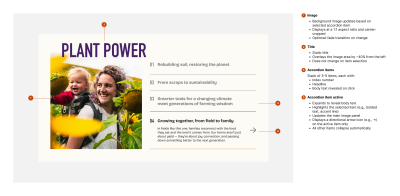

Source: Articles on Smashing Magazine — For Web Designers And Developers | Read More
Your past shapes who you are as a designer, no matter where your career began or how unexpected your career path may have been. Stephanie Campbell shows how those lessons can sharpen your instincts, strengthen collaboration, and help you become a better designer today.
Design career origin stories often sound clean and linear: a degree in Fine Arts, a lucky internship, or a first job that launches a linear, upward path. But what about those whose paths were not so straight? The ones who came from service, retail, construction, or even firefighting — the messy, winding paths that didn’t begin right out of design school — who learned service instincts long before learning design tools?
I earned my Associate in Science way later than planned, after 15 years in fine dining, which I once dismissed as a detour delaying my “real” career. But in hindsight, it was anything but. Those years built skills and instincts I still rely on daily — in meetings, design reviews, and messy mid-project pivots.
I still have the restaurant dream.
Whenever I’m overwhelmed or deep in a deadline, it comes back: I’m the only one running the restaurant floor. The grill is on fire. There’s no clean glassware. Everyone needs their check, their drink, and their table turned. I wake up sweating, and I ask myself, “Why am I still having restaurant nightmares 15 years into a design career?”
Because those jobs wired themselves into how I think and work.
Those years weren’t just a job but high-stakes training in adaptability, anticipation, and grace under pressure. They built muscle memory: ways of thinking, reacting, and solving problems that still appear daily in my design work. They taught me to adapt, connect with people, and move with urgency and grace.
But those same instincts rooted in nightmares can trip you up if you’re unaware. Speed can override thoughtfulness. Constant anticipation can lead to over-complication. The pressure to polish can push you to over-deliver too soon. Embracing your past also means examining it — recognizing when old habits serve you and when they don’t.
With reflection, those experiences can become your greatest advantage.
These aren’t abstract comparisons. They’re instincts built through repetition and real-world pressure, and they show up daily in my design process.
Here are five moments from restaurant life that shaped how I think, design, and collaborate today.
Reading a customer’s mood begins as soon as they sit down. Through years of trial and error, I refined my understanding of subtle cues, like seating delays indicating frustration or menus set aside, suggesting they want to enjoy cocktails. Adapting my approach based on these signals became instinctual, emerging from countless moments of observation.
The subtleties of reading a client aren’t so different in product design. Contexts differ, but the cues remain similar: project specifics, facial expressions, tone of voice, lack of engagement, or even the “word salad” of client feedback. With time, these signals become easier to spot, and you learn to ask better questions, challenge assumptions, or offer alternate approaches before misalignment grows. Whether a client is energized and all-in or hesitant and constrained, reading those cues early can make all the difference.
Those instincts — like constant anticipation and early intervention — served me well in fine dining, but can hinder the design process if I’m not in tune with how I’m reacting. Jumping in too early can lead to over-complicating the design process, solving problems that haven’t been voiced (yet), or stepping on others’ roles. I’ve had to learn to pause, check in with the team, and trust the process to unfold more collaboratively.

In fine dining, multitasking wasn’t just helpful, it was survival. Every night demanded precision timing, orchestrating every meal step, from the first drink poured to the final dessert plated. The soufflé, for example, was a constant test. It takes precisely 45 minutes — no more, no less. If the guests lingered over appetizers or finished their entrées too early, that soufflé risked collapse.
But fine dining taught me how to handle that volatility. I learned to manage timing proactively, mastering small strategies: an amuse-bouche to buy the kitchen precious minutes, a complimentary glass of champagne to slow a too-quickly paced meal. Multitasking meant constantly adjusting in real-time, keeping a thousand tiny details aligned even when, behind the scenes, chaos loomed.
Multitasking is a given in product design, just in a different form. While the pressure is less immediate, it is more layered as designers often juggle multiple projects, overlapping timelines, differing stakeholder expectations, and evolving product needs simultaneously. That restaurant instinct to keep numerous plates spinning at the same time? It’s how I handle shifting priorities, constant Slack pings, regular Figma updates, and unexpected client feedback — without losing sight of the big picture.
The hustle and pace of fine dining hardwired me to associate speed with success. But in design, speed can sometimes undermine depth. Jumping too quickly into a solution might mean missing the real problem or polishing the wrong idea. I’ve learned that staying in motion isn’t always the goal. Unlike a fast-paced service window, product design invites experimentation and course correction. I’ve had to quiet the internal timer and lean into design with a slower, more intentional nature.
Presentation isn’t just a finishing touch in fine dining — it’s everything. It’s the mint leaf delicately placed atop a dessert, the raspberry glace cascading across the perfectly off-centered espresso cake.
The presentation engages every sense: the smell of rare imported truffles on your truffle fries, or the meticulous choreography of four servers placing entrées in front of diners simultaneously, creating a collective “wow” moment. An excellent presentation shapes diners’ emotional connection with their meal — that experience directly impacts how generously they spend, and ultimately, your success.

A product design presentation, from the initial concept to the handoff, carries that same power. Introducing a new homepage design can feel mechanical or magical, depending entirely on how you frame and deliver it. Just like careful plating shapes a diner’s experience, clear framing and confident storytelling shape how design is received.
Beyond the initial introduction, explain the why behind your choices. Connect patterns to the organic elements of the brand’s identity and highlight how users will intuitively engage with each section. Presentation isn’t just about aesthetics; it helps clients connect with the work, understand its value, and get excited to share it.
The pressure to get everything right the first time, to present a pixel-perfect comp that “wows” immediately, is intense.
I’ve had to let go of the idea that polish is everything and instead focus on the why, describing it with clarity, confidence, and connection.
In fine dining, teamwork isn’t just helpful — it’s essential. Every night, success depends entirely on collaboration. The hostess seats guests, the bartender crafts drinks, the chefs prepare dishes, bussers swiftly clear tables, dishwashers provide spotless glasses — each role is critical, and without one, everything falls apart. You quickly learn there’s no ego or question about whether you could do it better alone. You know that teamwork is the only way, which may mean temporarily stepping outside your role to buss your table or jump behind the dishwasher to get clean glasses. Fine dining is truly a well-oiled machine — everyone must trust and rely on one another entirely.
In product design, it’s easier to slip into a silo inadvertently. Unlike restaurants, it can feel natural to work independently, maintaining biases and assumptions, or pushing work forward without additional feedback. But great design thrives on intentional collaboration and shared accountability, especially within an agency setting. Collaborate early, not alone. Actively embracing your support system — joining a UX call even when you’re not officially invited — can give critical insights far before wireframes or comps are developed, helping you ask better questions and make smarter assumptions.
In restaurant service, stepping in unannounced to address an issue was seen as helpful, even necessary. But in design, jumping in without alignment can confuse roles or interrupt someone else’s process. I’ve learned that collaboration isn’t about taking over but staying connected. I’ve had to get better at asking before helping, syncing instead of assuming, and treating the handoff not as an ending but as an open communication thread.

In fine dining, pressure isn’t an occasional event — it’s the default setting. Every night is high stakes. Timing is tight, expectations are sky-high, and mistakes are rarely forgiven. Composure becomes your edge. You don’t show panic when the kitchen is backed up or when a guest sends a dish back mid-rush. You pivot. You delegate. You anticipate. Some nights, the only thing that kept things on track was staying calm and thinking clearly.
“This notion of problem solving and decision making is key to being a great designer. I think that we need to get really strong at problem identification and then prioritization. All designers are good problem solvers, but the really great designers are strong problem finders.”— Jason Cyr, “How being a firefighter made me a better designer thinker”
The same principle applies to product design. When pressure mounts — tight timelines, conflicting feedback, or unclear priorities — your ability to stay composed can shift the energy of the entire project.
Composure isn’t just about being calm; it’s about being adaptable and responsive without reacting impulsively. It helps you hold space for feedback, ask better questions, and move forward with clarity instead of chaos.
There have also been plenty of times when a client doesn’t resonate with a design, which can feel crushing. You can easily take it personally and internalize the rejection, or you can pause, listen, and course-correct. I’ve learned to focus on understanding the root of the feedback. Often, what seems like a rejection is just discomfort with a small detail, which in most cases can be easily corrected.
Perfection was the baseline in restaurants, and pressure drove polish. In design, that mindset can lead to overinvesting in perfection too soon or “freezing” under critique. I’ve had to unlearn that success means getting everything right the first time. Now I see messy collaboration and gradual refinement as a mark of success, not failure.
I still dream about the restaurant floor. But now, I see it as a reminder — not of where I was stuck, but of where I perfected the instincts I use today. If you’re someone who came to design from another path, try asking yourself:
Once you see the patterns, start using them.
Name your edge. Talk about your background as an asset: in intros, portfolios, interviews, or team retrospectives. When projects get messy, lean into what you already know how to do. Trust your instincts. They’re real, and they’re earned. But balance them, too. Stay aware of when your strengths could become blind spots, like speed overriding thoughtfulness. That kind of awareness turns experience into a tool, not a trigger.
Your past doesn’t need to look like anyone else’s. It just needs to teach you something.
I want to express my deep gratitude to Sara Wachter-Boettcher, whose coaching helped me find the clarity and confidence to write this piece — and, more importantly, to move forward with purpose in both life and work. And to Lea Alcantara, my design director at Fueled, for being a steady creative force and an inspiring example of thoughtful leadership.